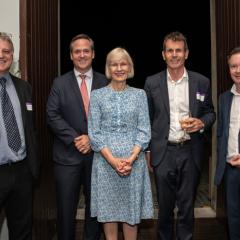Natural gas social licence: how Queensland stacks up

Research centre of excellence, The University of Queensland Centre for Natural Gas, has tested Queensland’s experience against the 'Golden Rules' of gas - a set of principles developed by the International Energy Agency to guide what it takes for natural gas developments globally to gain better social acceptance.
The ‘Golden Rules’ were developed largely against a back-drop of US shale gas developments. While Queensland’s coal seam gas (CSG) development experience has been very different, the rules were designed to be relevant for gas developments across the globe, and are generally recognised to be insightful.
The Golden Rules are a set of 22 principles designed to guide the gas industry and governments in establishing new gas developments. It includes rules such as: the need to measure, disclose and engage; to watch where you drill; to isolate wells and prevent leaks; to treat water responsibly; to eliminate venting, minimise flaring and other emissions; to be ready to 'think big'; and to ensure a consistently high level of environmental performance.
Social research expert Dr Kathy Witt led the investigation, with a view to identifying opportunities to improve industry performance in Queensland and to show how the Golden Rules could be updated for future projects or application in other jurisdictions.
The social licence imperative
Director of UQ’s Centre for Natural Gas, Professor Andrew Garnett, says the importance of achieving and maintaining a ‘social licence’ is imperative for industry to survive and thrive.
“If the legitimacy of industry hinges, at least in part, on whether people can come to believe that they have been treated fairly and will benefit from developments, then a set of high level guidelines or rules may help set initial expectations and provide a baseline guide for ongoing monitoring of performance and identifying areas where focussed effort may be needed,” he says.
“That leaves the big question – what are the right rules?”.
With some regional tweaking, strong potential for use as an evaluation framework
Professor Garnett drove the intensive 6-month study, examining the International Energy Agency’s “Golden Rules of Gas” against the Australian context.
Using interviews with high level industry and government personnel, science and policy experts, and community leaders, the research team drilled down into the extent to which the experience of coal seam gas development in Queensland aligned with the Golden Rules, and if the rules could be used as a relevant measure of industry and regulator performance here in Australia.
The key research findings were:
- The performance of the CSG industry in Queensland in relation to the Golden Rules was generally thought to have improved over time as the industry and the regulatory environment matured.
- Community acceptance is underpinned by the quality and completeness of information disclosure and stakeholder engagement over the lifecycle of the industry.
- While government granted licenses and regulatory compliance may be sufficient for the industry to get started, demonstrating a clear trajectory of improvement in social and environmental performance may be the most critical factor in gaining and maintaining social licence to operate.
- The International Energy Agency’s Golden Rules are, in the most part, applicable to the Queensland context, and have a strong potential for use as an evaluation framework for natural gas development in Australia and overseas.
Professor Garnett said it was interesting that many of the respondents talked about the improvement they’d seen over time and the expectation that this would continue.
“The strongest expectation coming through in the analysis was for even more transparency and disclosure from both the industry and government,” he said.
“It is not about only being seen to be doing the right thing, or extensive reporting to government; it’s about demonstrably improving and transparently reporting the information - and making it widely accessible.”
Project lead, Dr Kathy Witt says the findings align with two other major socio-economic research projects being led by the UQ Centre for Natural Gas.
“Key themes are mirrored in a community indicators tool developed at UQ which measures the socio-economic impacts of large projects on local communities, and a soon to be released project which measured stakeholder trust in the CSG industry, and how and why that trust changes over time,” she said.
Dr Kathy Witt noted that, perhaps due to their origin, the research team found the rules to be rather industry-centric and recommended an evaluation tool that placed greater emphasis on community concerns and opportunities.
“There is room to improve when it comes to measures of social performance or local community impact,” she says. “However overall the study showed that with some local tailoring, the ‘Golden Rules of Gas’ form an excellent check-list for gas development projects – both established and new.”
More details:
- What
- A pilot study was conducted by The University of Queensland Centre for Natural Gas aimed at understanding how the CSG experience in Queensland reflects the International Energy Agency’s Golden Rules and whether these rules can be used as a framework for the evaluation of industry performance and community acceptance in Australia.
- How
- Researchers conducted interviews and surveys with selected stakeholders to gather qualitative and quantitative data in a mixed methods approach. The stakeholders included industry representatives, government representatives, community representatives, and experts.
- Stakeholders were asked to rate on a scale of 1 to 5 (1 being poor to 5 being excellent), in their experience, (1) how well they thought Queensland CSG industry practice adhered to the Golden Rules (2) how well they thought the policy and regulatory environment reflected the Golden Rules and (3) how important they thought each of the Golden Rules were for community acceptance of the industry.
- Project findings
- Measure, disclose and engage was considered the most important rule for community acceptance of the industry, but also had the largest gap between policy and regulation and importance for community acceptance. This rule addresses information disclosure, community engagement and regional benefit sharing.
- Disclosing information and engaging with communities was seen as the most important driver of community acceptance of the industry – more important than technical and environmental compliance.
- Across all of the Golden Rules, industry practice was rated higher than the policy and regulatory environment. Respondents commented how the development of the regulatory framework did not appear to keep pace with the rapid development of the industry.
- Nearly all respondents pointed out that allocating a single score to the experience was difficult, as industry practice had improved considerably over time, and that the role of government as both the regulator and the enabler is complex.
- Notwithstanding, the regulatory frameworks around groundwater management and well integrity were described as exemplary cases, with some respondents referring to these as ‘world leading’ and ‘world class’.
- Although scoring relatively lower, engagement and integration with communities was seen to have improved over time as the industry began “to understand the need to operate as a part of the social and economic fabric of the regions it operates in”.
- The importance of demonstrating a trajectory of improvement in each of the rules over time emerged as key to maintaining social licence to operate.
- Be ready to think big is about planning at the appropriate scale of development, regional coordination and cumulative effects, but shows a large gap between industry and regulatory performance and importance for community acceptance. In the Queensland experience, this represents a legacy gap, where capital investment decisions made in the past and the results of those decisions and cannot easily be changed now - such as large-scale investment in infrastructure.
- The Golden Rules translate well into an effective evaluation framework for industry performance and community acceptance.
- The Golden Rules could be strengthened with an increased focus on social as well as environmental performance. More specifically, including social baseline assessment and monitoring of social and economic indicators, transparency in performance reporting, community engagement and benefit sharing.
- For areas where natural gas development has not yet occurred, these findings highlight the importance of coordination and management of cumulative impacts.
- Full report
- Final project report: The coal seam gas industry in Queensland and the 'Golden Rules' of gas (2020)
The International Golden Rules of Gas
The International Energy Agency devised 22 rules. These are clustered into seven key overarching categories:
|
Measure, disclose and engage
Watch where you drill
Isolate wells and prevent leaks
|
Treat water responsibly
Eliminate venting, minimise flaring and other emissions
Be ready to think big
Ensure a consistently high level of environmental performance
|



